Ford – COBB Traction Control
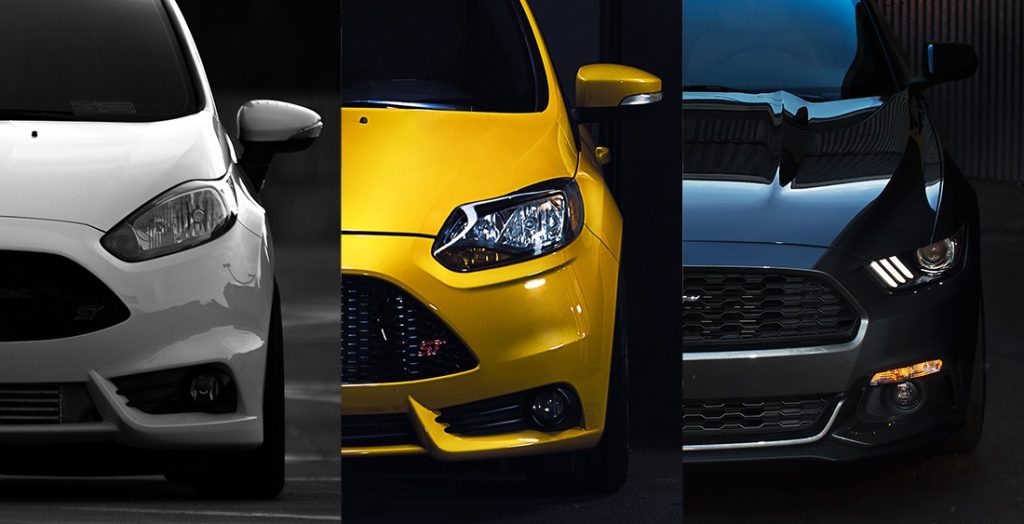
The Mustang EcoBoost, Fiesta ST, and Focus ST are all torque monsters from the factory. Take one in stock form, slap on any of the slew of aftermarket parts available, and your EcoBeast becomes even more savage. But no matter how much power your car can make, it’s worthless if it doesn’t get to the ground. That’s where COBB Traction Control comes in.
COBB Traction Control is a custom feature available only with the Accessport. It doesn’t involve any extra sensors, installation, or hard part changes. This makes it easy to improve road course or straight line track times on completely stock EcoBoosts, highly modified race cars, or any other supported Ford in between. Essentially, if your wheels are uncontrollably spinning at any time during any race, this feature can help.
“Doesn’t my car have traction control from the factory?” Although there is a factory system in place, it is quite intrusive and in many situations removes far too much power output than necessary. This may work well for keeping you on an icy road but is far from optimal if performance is the goal. “Well I can turn that factory traction control off!” This is also true but can often lead to uncontrollable spin, especially with modified cars. Even more so with front-wheel drive modified cars. It just so happens we have one of those. Meet our Stage4 SEMA Ford Focus ST:
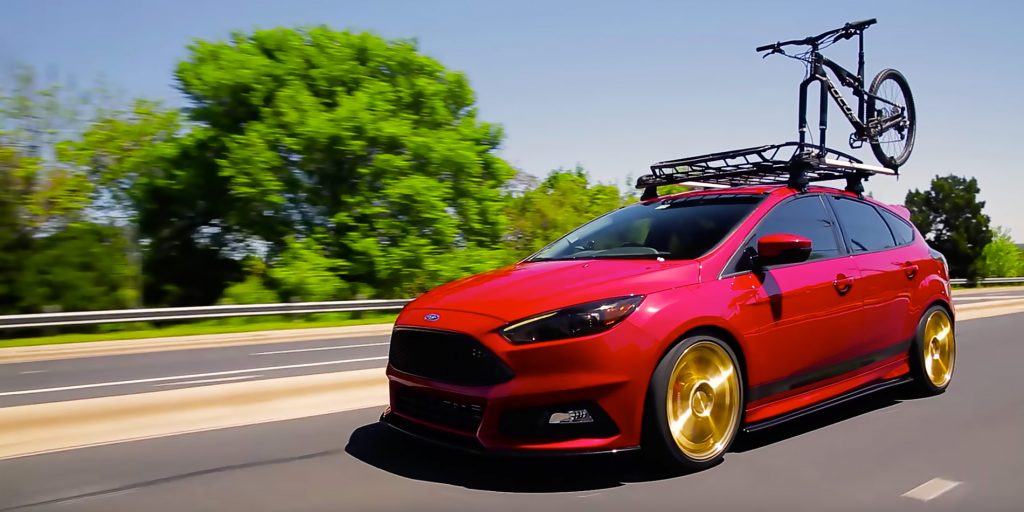
This vehicle has the complete COBB Stage3 Power Package which includes a full turboback exhaust, upgraded front mount intercooler, and intake. This Focus ST also sports an upgraded turbocharger. Altogether this makes about 330hp and 360tq to the wheels and forces this Focus to pull like a freight train all the way to redline! But enough about the car and back on to COBB Traction Control. The point is, it’s capable of spinning the tires pretty easily which makes it the perfect candidate to show the benefits of the feature.
The current options on your EcoBoost vehicle are traction control on, which limits too much power, and traction control off, which allows too much wheel spin. COBB Traction Control can be configured to work somewhere in the middle where optimal performance can be had. It works by taking the vehicle speed (averaged from the rear two wheels on our Focus ST) compared to a driven speed (front two wheels on our Focus ST) and then uses a properly calculated slip number into our own proprietary PID loop algorithm. This will then calculate the proper amount of ignition timing to be reduced based on the amount of slip. The simple test below gives a better idea of how the system works and shows how even basic settings can provide an improvement.
To test traction control we needed a traction event that was easily repeatable and had limited variables. A simple 2nd gear pull at wide open throttle from low RPM to near redline was easily repeatable. Then, the time it took to accelerate from 30 to 50 miles per hour during that pull was measured. This speed range was chosen since it yielded very consistent results and captured the period where wheel spin occurs. These tests were performed on the same section of a closed course all within a few minutes on the same day. Below is the acceleration data collected with a VBox Sport and the ECU data collected with an Accessport. Compared is the same run with factory traction control, the factory traction control off, and the exact same map but with COBB Traction Control added with a generic 20% slip setting across the table.
Factory Traction Control
With the factory traction control enabled our Stage4 Focus ST accelerated from 30 to 50 miles per hour in 2.01 seconds.
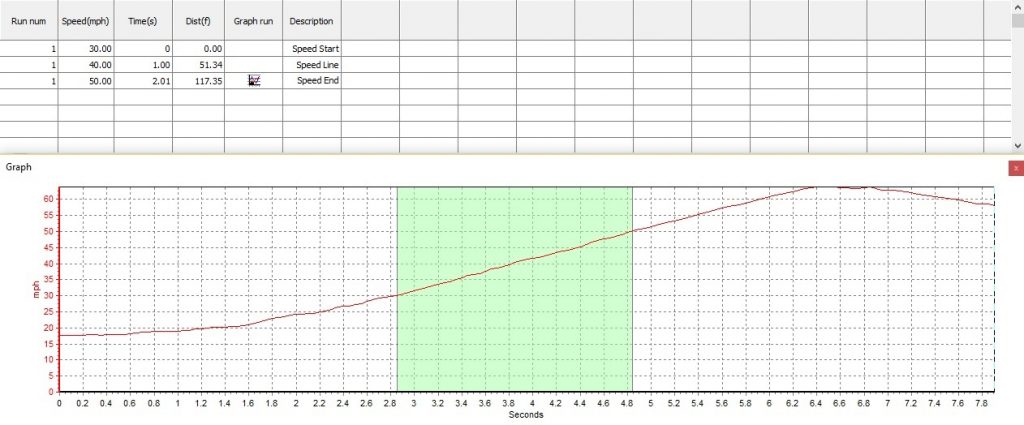
The SEMA Focus ST begins pulling hard but right at the 4 second mark on the x axis there is a bit of a flat spot (nearly a negative slope) in our acceleration. This is right where boost really kicks in which spins the tires causing the factory traction control to reduce boost and pull timing. This can be seen in the datalog from our Accessport.
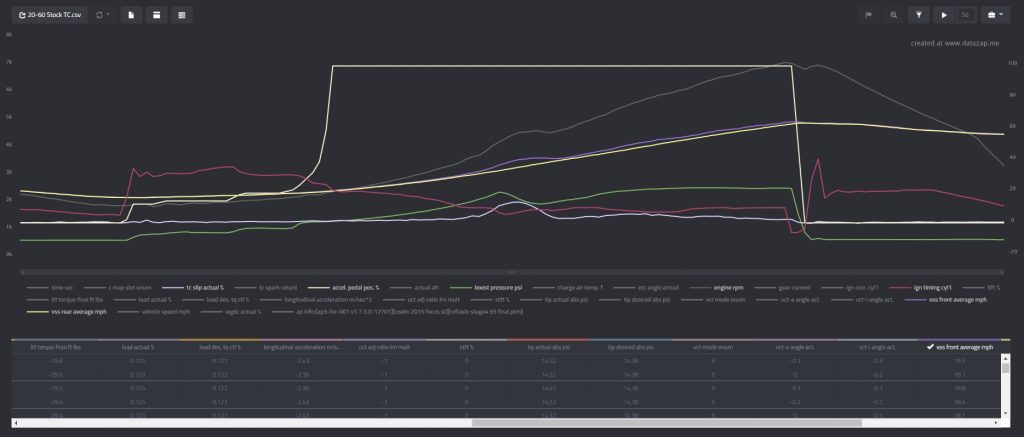
The above datalog (click here for an interactive page of this same log) is taken from an Accessport and shows a few key variables in explaining our traction control event. Among the variables are:
- Accel. Pedal Pos. % – This variable shows how far the gas pedal is pressed. The area where the car is at wide open throttle (100%) is the data we want to examine.
- Boost Pressure (PSI) – This is the amount of boost in PSI the vehicle’s MAP sensor is reading.
- VSS Front Average – The average speed of the front two wheels based on the front wheel vehicle speed sensors.
- VSS Rear Average – The average speed of the rear two wheels based on the rear wheel vehicle speed sensors.
- TC Slip Actual – This monitor shows the difference as a percentage between VSS Front Average and VSS Rear Average.
- Ign Timing Cyl 1 – This shows the ignition timing in cylinder 1.
Notice that only about an 8% difference in wheel speed (TC Slip Actual) between the front (VSS Front Average) and rear (VSS Rear Average) wheels causes the factory traction control system to reduce boost (Boost Pressure (PSI)) and pull timing (Ign Timing Cyl 1 ).
Traction Control Off
With the factory traction control off, our Stage4 Focus ST accelerated from 30 to 50 miles per hour in 1.93 seconds.
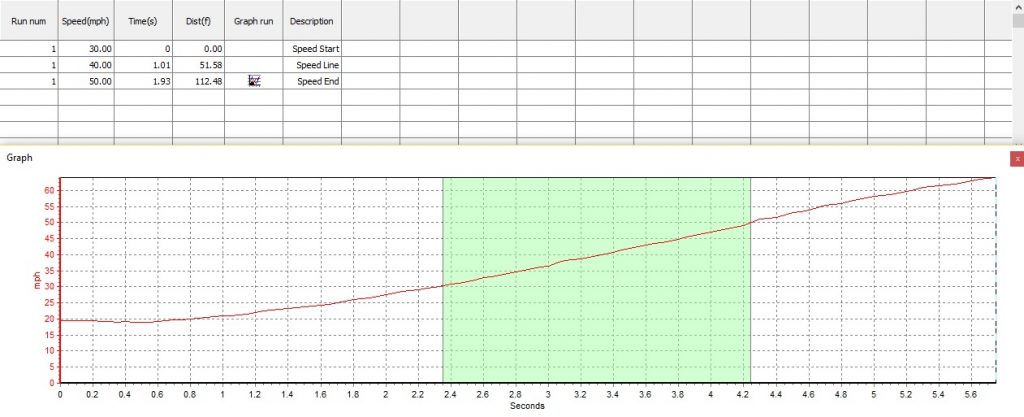
The car is faster without the invasive traction control. It is nearly a full tenth faster in acceleration from 40-50 over the run with factory TC enabled. Let’s dive into the datalog for more detail.
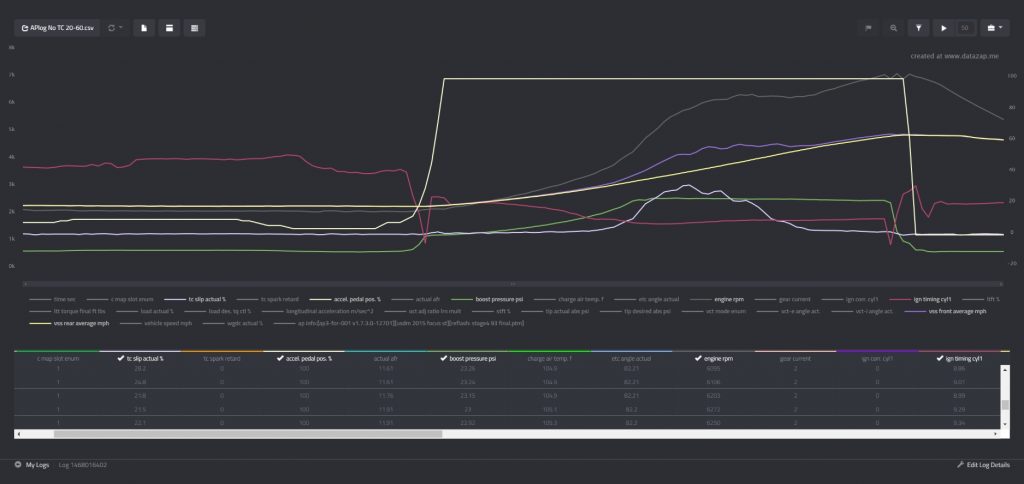
Here we see the datalog showing the same monitors as our previous run with the factory traction control system enabled. We can plainly see the benefit as boost (Boost Pressure (PSI)) and timing (Ign Timing Cyl 1 ) aren’t neutered through an overbearing traction control system. But, we also see difference in wheel speed (TC Slip Actual) peak at over 30%! This car is equipped with sticky tires which allowed it to regain traction. Lesser tires would likely continue to slip all the way to redline with no traction control active. Although this run was faster, let’s see if we can implement some simple changes with COBB Traction Control and improve our acceleration test results.
COBB Traction Control
With COBB Traction Control set with a maximum of 20% slip, our Stage4 Focus ST accelerated from 30 to 50 miles per hour in 1.80 seconds.
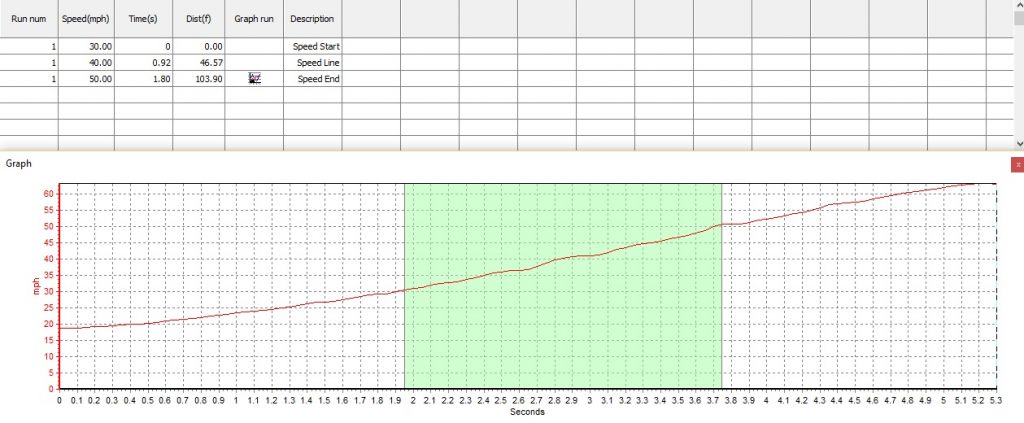
With COBB Traction Control enabled to allow a maximum slip of 20%, the FoST gains nearly a full tenth over each 10 mph.
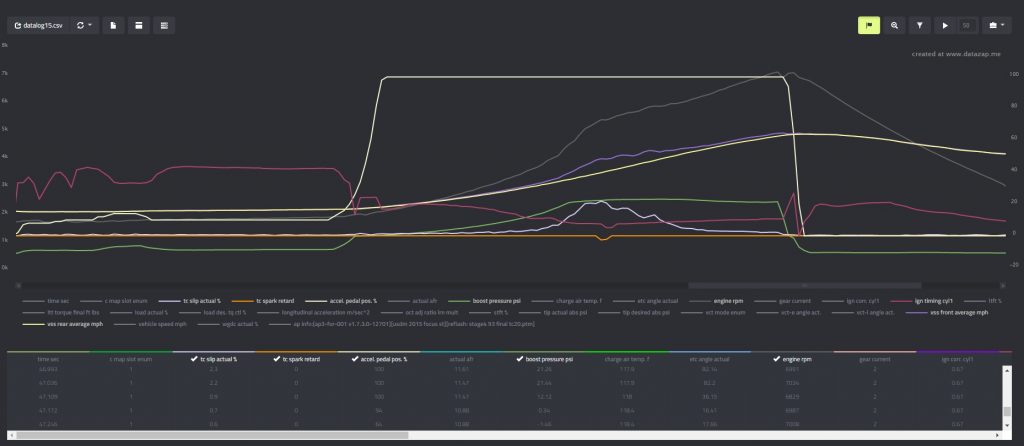
Here is the datalog for the run above. The same monitors as the previous logs are present and the TC Spark Retard monitor is added. This monitor shows the amount of ignition timing reduced as a result of the COBB Traction Control in effect. You can see this value change when our TC Slip Actual exceeds 20%. Slightly limiting the amount of wheel spin improved the car’s acceleration.
The above is a very basic test used to show COBB Traction Control in action. The capability of the system is much more robust. You can also set up tables that limit slip to a certain amount based on yaw (twist around a vertical axis) or steering wheel angle! This can greatly improve lap times by allowing the driver maximum acceleration out of every corner.
The optimal amount of allowed slip will depend on the vehicle, modifications, tire compound, and racing surface. Get with a Protuner today to get COBB Traction Control dialed in for your vehicle and watch the lap times fall!

I don’t need a “ProTuner” to setup the values for my car. In fact, a “Protuner” CAN’T set up ANY car on a dyno or a short street drive for the expected use and expect optimum results for the user. Why didn’t/don’t you enable it for the ATR users? Can I expect Cobb to enable all the ATR features when the user completes the “training”? For those of us that have been using various piggyback tuners and the AP/ATR from the time it was released for the Mazdaspeeds back in ~2008, I don’t think we require the formal training to tune/setup our own vehicles. I’ll certainly pay the registration fee to help with your continued ATP/ATR development, and overall business goals. Please consider grandfathering those of us that have many years experience with the AP/ATR and tuning our own high performance vehicles.
Thanks for your awesome support motorsports tuning!
FORZDA 1 from the MazdaSpeed Forums and now FORZDA 2 on the Fiestastforum.com forum
Hey Joseph,
When Accesstuner returns, it will have feature parity with it’s big brother Accesstuner Pro. So, users with that software will be able to custom tune and set up COBB Custom Features as they wish.
Marshall@COBB
Do you just have to put it in sport mode, or ESC off to use this?
Hey Jesse,
Either mode will turn off the factory traction control systems and allow the COBB Traction Control to function as intended.
Marshall@COBB
What turbo did you guys use for the “stage 4”? Is there any plans for providing OTS tunes for upgraded turbos?
We are using a prototype stock location kit that is sized comparatively to a GT3071R.
Marshall@COBB
Hi Marshall, thanks for the reply! I’m hoping that means that you potentially be offering tunes for that same product in the future.
trabajan bien esos mapas v400 solo que , con la nueva actualizacion se cambia al mapa slot 2, sin moverle a nada y la aguja de las revoluciones sube y baja y como mi coche es 2014 no trai boton de crucero para poder modificar el slot. ojala lo arreglen rapido 🙁 por que no lo puedo utilizar bien.
Hi Edgar, we released a fix for the map slot bug today! Use Accessport Manager to update your Accessport and then flash a v401 map file to the car’s ECU.
Marshall@COBB
So is this something you have to activate or is it just part of the ECU flash?
The Traction Control currently requires setup via Accesstuner, so a visit to a Protuner would be required. In the future, we do plan to implement Accessport adjustments for that feature.
Marshall@COBB
Is the Cobb Traction Control going to be available using the OTS tunes anytime soon, just using the Accessport?
Hi Brian,
It is available on the OTS maps. However, to get the most out of the feature, custom tuning would be required.
Kyle@COBB
Does Cobb have a way to change/control the eTVC?
Hi Kevin,
We do not alter the stock system but you are able to completely disable it and then use the COBB traction control which is able to be setup any way you want.
Kyle@COBB